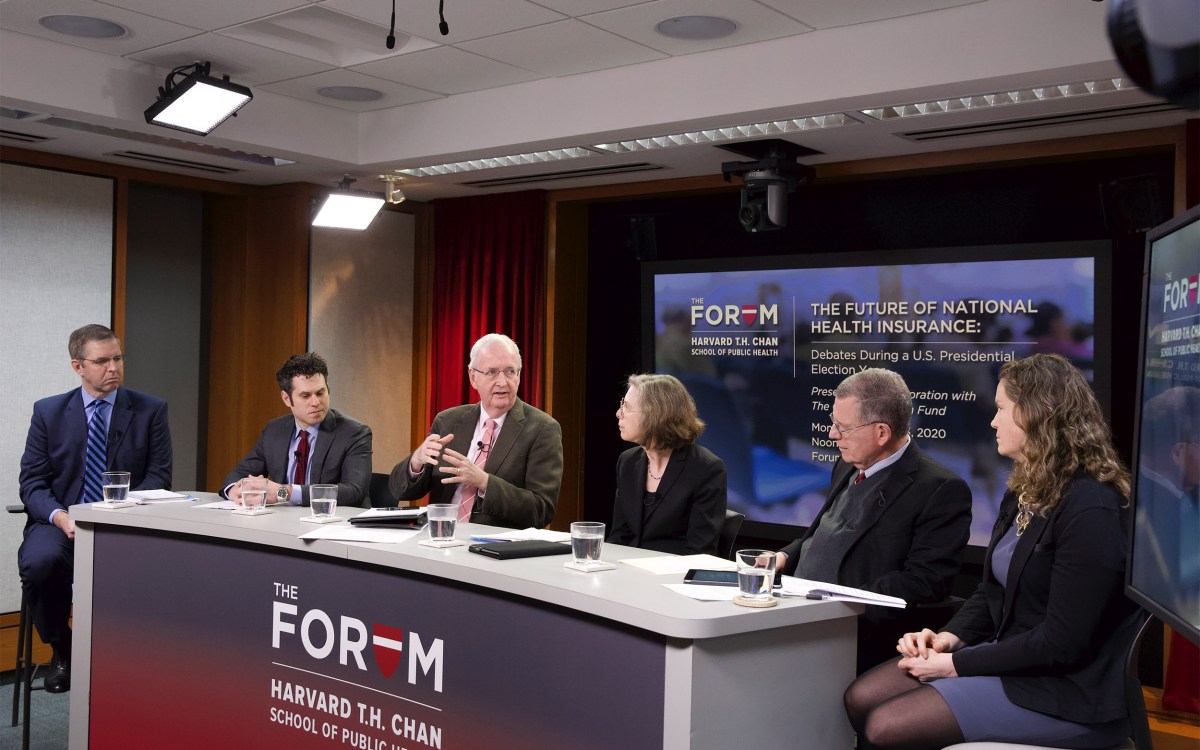
“When we talk about Medicare ‘going broke,’ Medicare can’t go broke, because it’s not a corporation in that sense. But it could start running out of money …,” says John McDonough, Harvard T.H. Chan School of Public Health.
Jon Chase/Harvard Staff Photographer
Prospect dim for Biden plan to bolster Medicare, health policy expert says
Chan School’s McDonough cites divided Congress, says looming funding crisis is, oddly enough, result of program design
Part of President Biden’s new budget, released last week, aims to bolster the solvency of a key part of Medicare by raising taxes on those making more than $400,000 and lowering prescription drug costs. The government-run health insurance program for more than 65 million elderly and disabled Americans is heading toward a crisis in 2028, when one of its four parts, Part A, the portion of the trust fund that finances hospital visits, will begin running short of money. Biden’s proposal to avoid the shortfall is expected to face tough opposition from congressional Republicans. The Gazette spoke with health care policy expert John McDonough, professor of the practice of public health at the Harvard T.H. Chan School of Public Health, about the prospects the dilemma will be averted.
Q&A
John McDonough
GAZETTE: How urgent is the Medicare funding crisis?
McDONOUGH: First, it’s not a Medicare funding crisis; it’s a Medicare Part A funding crisis. Part A is the Medicare hospital program, mostly. And the crisis is by design. The real architect of Medicare — in the mid 1960s — was Congressman Wilbur Mills from Arkansas, then chairman of the House Committee on Ways and Means, who was never much of a fan of Medicare. But when 1965 came along and Lyndon Johnson had supermajorities in the House and the Senate and all Democrats wanted to create a medical care insurance program for the elderly, he had to go with the flow or he would have been washed away. But he knew that the program being created would be inherently unstable and financially at risk because the pressures on medical care growth are relentless. So, they created this structure whereby Congress would be compelled to periodically go back and re-examine the financing to manage growth into the future. This is not a surprise for people familiar with the program’s history. This is one of its design features.
GAZETTE: And they did that by building in a financial model whose very nature requires tending and care, rather than congressional reauthorization?
McDONOUGH: It doesn’t require reauthorization. Part A is financed by that Medicare payroll tax, on your paycheck stub. Part B — physician services — is financed through enrollee premiums and federal appropriations. So each part — A, B, C, D — has its own financing. When we talk about Medicare “going broke,” Medicare can’t go broke, because it’s not a corporation in that sense. But it could start running out of money, in which case, the federal government would not be able to reimburse hospitals and other parts of Part A at 100 percent of what they would otherwise be obligated to pay. It would create shortfalls in reimbursement for legitimately delivered services by hospitals and by other parties in Part A.
GAZETTE: So the crisis, such as it is, applies to the part of Medicare that pays for hospital services, mainly. Not Part B, which is physician services. What are Parts C and D for?
McDONOUGH: Part D was created in 2003 and is the program for outpatient prescription drugs. It is financed mostly by federal appropriations and by enrollee premiums. Part C is more popularly known as Medicare Advantage. Parts A and B are known as traditional Medicare and have been what most people typically join. If you enroll in A and B, when you go to a hospital or physician, the hospital or physician bills the federal government and gets a check back. With Parts C and D, you don’t enroll into a federal program, you enroll with a private insurance company and the company provides all of your services and gets a single lump sum annual payment from the federal government for you — risk adjusted for how old and how sick you are. That program was created because private insurers, mostly HMOs — health maintenance organizations — said, “We can provide better care at lower cost.” In some ways, they provide better quality, and in other ways they don’t. And it’s always been more expensive than traditional Medicare. Right now, a big thing going on in Medicare is that this year for the first time more people are joining part C than traditional Medicare Parts A and B. It’s kind of like a dog with a tail, but this year that tail is becoming bigger than the dog itself. It’s creating all kinds of discomfort and awkwardness because all of the money that feeds Part C is siphoned off from Parts A and B.
GAZETTE: What is the attraction to consumers for Part C? Is it to keep private health insurance rather than go into a government program?
McDONOUGH: It’s many things, but the important thing is most people can enroll in Medicare Advantage at significantly lower premium costs than A and B. Parts A and B have many holes. So almost everybody who is above the poverty line buys supplemental coverage, called Medigap, to pay for things that traditional Medicare doesn’t cover. But many people — about half — get into Medicare Advantage and don’t have to pay a premium. It’s very attractive. It also offers limited — they don’t use that word — dental, vision, and hearing benefits. But the emphasis is on “limited” because it’s a lot less than people imagine. And there are armies of health insurance brokers who work for Medicare Advantage carriers and who make money by enrolling people in Medicare Advantage plans for whom they work.
GAZETTE: What do you think of President Biden’s proposal to raise taxes on wealthier individuals and tighten prescription drug costs? It seems straightforward, but is it a real proposal or just politics?
McDONOUGH: It’s real in the sense that it could happen. There’s nothing in there that is beyond the realm of possibility except that, in this two-year Congress with the Republicans in control of the House, there is no way that the Republican majority would agree to it. The principal commandment for being a Republican is: “Thou shalt not ever raise taxes on anyone, anytime, anywhere, anyhow,” and in particular taxes on the affluent and corporations. That’s what Biden is proposing to do and something that Democrats don’t mind. So if you have Democrats holding the White House and the Senate and take back the House in 2024, then in the next Congress it is entirely possible that something like this could get through as part of a reconciliation bill, which only requires 51 votes in the Senate and a majority in the House. That would be doable, and then Democrats could take credit for saving Medicare from bankruptcy until 2050.
GAZETTE: This is part of the president’s proposed budget, but is this issue too hot with Republicans in control of the House? Is this a can that is going to just get kicked down the road?
McDONOUGH: Yes. Because the difficulty is that Democrats don’t mind raising taxes, particularly for something like Medicare, and they do not want to cut benefits. And Republicans are in a box because they’ve agreed publicly to no cuts and they, philosophically, will refuse to support higher taxes. I look forward to whatever plan they might advance, because there are only two ways to move forward: more taxes and/or more cuts.
GAZETTE: Taking politics out of it, is there a best solution from your standpoint?
McDONOUGH: In 2010, when the ACA passed, the private plans in Medicare Advantage were costing $1.20 for every dollar spent on traditional Medicare. Today, it’s about $1.04 or $1.05 for every dollar spent on traditional Medicare. But 4 or 5 cents, because the program has grown so big within Medicare, is now also a huge amount of money. So one easy way to pull back on Medicare Advantage is to bring it into parity with traditional Medicare. That would generate a lot of savings and would advance Part A solvency because Medicare Part C gets most of its money from A. So Part C — Medicare Advantage — has to be part of this solution one way or another. The insurers are making extraordinary amounts of money from this program.
GAZETTE: When you say that the money in part C comes from part A, is it because the patients in Part C would otherwise be enrolled in Part A or is it a more direct transaction?
McDONOUGH: Let’s say I’m in a Medicare Advantage plan, and I get a service at Beth Israel Deaconess Medical Center. The insurance company essentially bills Medicare Part A for that service.
GAZETTE: So Part A is paying $1.04 for every dollar they would otherwise pay for someone enrolled directly in Part A, and Congress could just decree that we’re only reimbursing Part C at the same rate, dollar for dollar, as Part A?
McDONOUGH: It’s more complicated than that. The key point is that it’s all interconnected. If Democrats control the House, the Senate, and the White House in 2025, I foresee that they will pass legislation that does a lot of things, including extending the life of the Part A trust fund and financing it significantly by creating parity between Medicare Advantage and traditional Medicare.







